Study on Spatiotemporal Coupling Between Urban Form and Carbon Footprint from the Perspective of Color Nighttime Light Remote Sensing
Abstract
Highlights
- A high-resolution color nighttime light remote sensing imagery (color-NLRSI) dataset was generated using an NSCT-IHS dual-transform fusion method, significantly improving the accuracy of built-up area extraction and spatial delineation compared to traditional NPP-VIIRS data.
- Applied to Guangzhou, this method revealed that urban spatial expansion is the dominant influencing factor of carbon emissions, with a standardized influence coefficient of 22.43%, substantially higher than those of economic development (10.34%) and urbanization rate (14.91%).
- The color-NLRSI dataset and the integrated technical framework provide a reliable, high-resolution foundation for accurately monitoring carbon emissions and urban dynamics, enabling fine-grained environmental governance and low-carbon spatial planning.
- The integration of color nighttime light data with spatiotemporal modeling reveals a distinct “core-periphery” heterogeneity in urban development-carbon emission relationships, highlighting the need for region-specific policies to mitigate carbon lock-in and promote sustainable transformation.
Abstract
1. Introduction
2. Research Data and Methods
2.1. Overview of the Study Area
2.2. Data Preprocessing
- (i)
- Landsat-8 OLI_TIRS dataset, sourced from the Geospatial Data Cloud Platform of the Computer Network Information Center at the Chinese Academy of Sciences (http://www.gscloud.cn) (accessed on 2 January 2025). Panchromatic images with a spatial resolution of 15 m and MS images with a spatial resolution of 30 m in the Guangzhou area spanning from 2013 to 2021 were chosen.
- (ii)
- NPP/VIIRS-like nighttime light remote sensing imagery dataset, obtained from the collaborative research efforts of Yu Bailang’s team and Chen Zuoqi’s team [27], consolidated and made available by the Yangtze River Delta Sub-center of the National Earth System Science Data Center (National Earth System Science Data Center (https://www.geodata.cn/) (accessed on 2 January 2025). With a spatial resolution of 500 m, NPP-VIIRS-like image data of the Guangzhou area from 2013 to 2021 were selected.
- (iii)
- Other statistical data were obtained from the Guangzhou Statistical Yearbook of the Guangzhou Municipal Bureau of Statistics (https://tjj.gz.gov.cn/) (accessed on 6 February 2025). Data on population, economic development, etc., of Guangzhou from 2013 to 2021 were selected.
2.3. Color Nighttime Light Remote Sensing Imagery Fusion Method Based on NSCT-IHS Dual Transform
- (i)
- Imagery preprocessing. Perform precise spatial registration on Landsat MS imagery (30 m) and Landsat PAN imagery (15 m). By selecting control points on the MS imagery and aligning them with the reference coordinates of the PAN imagery, ensure that their spatial positions, sizes, and directions are consistent. In view of the significant resolution difference between Landsat data and nighttime light remote sensing imagery (NLRSI, 500 m), resample both to a uniform resolution (40 m × 40 m) to ensure the spatial scale consistency of multi-source data.
- (ii)
- (iii)
- Histogram Matching. Perform histogram matching between the intensity component (I) obtained after IHS transformation and the PAN imagery with richer spatial details to optimize their statistical characteristics.
- (iv)
- NSCT Decomposition. Perform NSCT decomposition on the PAN imagery and the I component after histogram matching processing, respectively. This process decomposes the imagery into one low-frequency approximate component and multi-scale, multi-directional high-frequency sub-bands, facilitating the separation of different frequency components for key information extraction.
- (v)
- High-Frequency and Low-Frequency Fusion. The contours of imagery are often affected by the dominant energy information in low-frequency components. To ensure high-quality visual effects, it is necessary to select appropriate low-frequency sub-band coefficients. Based on the weight selection rule of regional energy, the system automatically identifies and selects regions with higher energy, and assigns optimal weights to these regions. This effectively enables the fused imagery to retain and highlight the features of high-resolution imagery, thereby improving the overall quality of the imagery. Assuming that the low-frequency components obtained after transforming the I components of the two images are IA and IB respectively, the fused low-frequency component IL is as follows [26]:
- (vi)
- IHS Inverse Transformation. Perform NSCT inverse transformation on the fused low-frequency components and the high-frequency coefficients selected according to the rules to reconstruct a new intensity component Inew. Then, perform the IHS inverse transformation Inew together with the original hue (H) and saturation (S) components, and finally generate the fused color nighttime light remote sensing imagery [21].
- (vii)
- (vii) Integration of Nighttime Light Data: The high-resolution intensity component (Inew) obtained from the inverse NSCT is replaced by the histogram-matched NPP-VIIRS-like nighttime light data. A final inverse IHS transformation is then applied to this modified intensity component (INTL), the hue (H), and saturation (S) components to generate the fused color nighttime light remote sensing imagery (Color-NTL). In the resulting RGB composite, the spectral information is derived from the MS bands, while the luminance is driven by the NTL data, which is primarily rendered in the blue channel.
- (i)
- Temporal analysis of Color-NTL imagery in specific regions: An investigation into temporal changes in Color-NTL imagery details across typical local regions, including urban centers, emerging development zones, and urban-rural fringes.
- (ii)
- Detailed comparison between Color-NTL and “NPP-VIIRS-like” nighttime light images: In the same specific region, compare the detailed presentation capabilities of Color-NTL images with the corresponding years’ “NPP-VIIRS-like” nighttime light images.
- (i)
- Continuous Enhancement of Nighttime Lights: Throughout the entire study period, the nighttime light index of Guangzhou shows a significant year-by-year upward trend, intuitively reflecting the situation of urban expansion and the growth of economic activities.
- (ii)
- Distinct Advantages of Color-NTL Imagery. In terms of spatial clarity, compared with the “NPP-VIIRS-like” nighttime light imagery, Color-NTL imagery has obvious advantages in spatial clarity, and the feature information, such as the internal road networks and building outlines of the city, has higher recognizability. In terms of detail presentation capability, Color-NTL imagery is more prominent in detail performance, and can more precisely depict the differences in light intensity and spectral characteristics of different functional areas (such as commercial areas, residential areas, and industrial areas) within the city, as well as the dynamic changes of small-scale urban structures.
3. Experimental Analysis
3.1. Spatiotemporal Analysis of Urban Built-Up Areas Based on Color Nighttime Light Remote Sensing Imagery
3.2. Spatiotemporal Analysis of Urban Carbon Emissions Based on Color Nighttime Light Remote Sensing Imagery
- (i)
- Emission reduction areas: The carbon emissions of Huadu District, Huangpu District, and Tianhe District in 2021 were significantly lower than those in 2013, reflecting the effectiveness of their industrial transformation or energy efficiency improvement.
- (ii)
- High-emission areas: As core industrial agglomeration areas, Baiyun District and Panyu District have continuously maintained high levels of carbon emissions.
- (iii)
- Low-emission areas: Due to the low density of permanent residents, abundant land resources, and limited scale of energy consumption in Conghua District, its carbon emissions have long been at the lowest level in the city; although Yuexiu District is a core urban area, restricted by the narrow geographical space, its overall emissions also remain at a low level.
- (i)
- The growth of carbon emissions from 2013 to 2021 showed significant spatial directionality, mainly concentrating in the NW and SSE directions, which is highly consistent with the industrial-dominated growth of Baiyun District (NW direction) and Panyu District (SSE direction).
- (ii)
- The growth proportion in the N direction was the smallest, confirming the continuous low-carbon status of Conghua District in this direction.
- (iii)
- On the whole, the carbon emission expansion of Guangzhou showed a clear pattern of “Northwest-Southeast axial extension”, which profoundly reflects the core driving role of industrial spatial layout and regional economic growth.
3.3. Construction of a Coupling and Coordination Model Between Nighttime Light and Carbon Emissions
3.4. Empirical Analysis on the Coupling Mechanism Between Urban Built-Up Area Expansion and Carbon Emissions
4. Conclusions and Discussion
4.1. Conclusions
- (i)
- Color nighttime light data, with its high spatiotemporal resolution, surpasses traditional statistical data and panel models by effectively addressing the issues of lag and coarse spatial granularity found in official data. The GTWR model enhances the analysis of spatiotemporal heterogeneity significantly more than the conventional STIRPAT model.
- (ii)
- Contrary to the “polycentric equilibrium” model of the Yangtze River Delta Urban Agglomeration, Guangzhou demonstrates a polarized “core stagnation-peripheral leap” pattern. Historical protection constraints have slowed growth in the Yuexiu District, underscoring the tension between cultural heritage preservation and low-carbon development. This situation reveals that the marginal carbon emission intensity of Guangzhou’s urban expansion exceeds the global city average. Furthermore, regions with extreme population sizes exhibit a stronger driving effect, supporting the theory of “emission peaks in medium-sized cities.”
- (iii)
- The study elucidates a three-tier transmission pathway of the “expansion-heat island-high emission” cycle, offering a more comprehensive perspective than prior studies focused on singular paths. Peripheral regions should limit industrial land expansion, while central urban areas must overcome spatial lock-in effects, exemplified by the low-carbon service industry model in Tianhe District. This approach contrasts with the conventional “whole-region emission reduction” policy framework.
4.2. Discussion
- (i)
- Urban expansion markedly influences carbon emissions, with highly expanded areas exhibiting standardized coefficients exceeding 0.9, compared to less expanded areas with coefficients below 0.8. This effect stems from construction land encroaching on carbon sinks, industrial agglomeration hindering energy structure optimization, and the perpetuation of the “expansion-heat island-high emission” cycle.
- (ii)
- The evolution of coordination degree reveals a distinct pattern of “core lag-peripheral leap” (average value: 0.21 → 0.46). Technological innovations, such as photovoltaic smart lighting, have the potential to overcome transformation bottlenecks. However, historical urban areas remain constrained by spatial lock-in effects, as evidenced by Yuexiu District’s growth rate lagging by 32%.
Author Contributions
Funding
Data Availability Statement
Acknowledgments
Conflicts of Interest
References
- Wu, Y.; Zhang, Q. The Confrontation and Symbiosis of Green and Development: Coupling Coordination Analysis between Carbon Emissions and Spatial Development in Urban Agglomerations of China. Sustain. Cities Soc. 2024, 106, 105391. [Google Scholar] [CrossRef]
- Liu, B.; Tian, C.; Li, Y.; Song, H.; Ma, Z. Research on the Effects of Urbanization on Carbon Emissions Efficiency of Urban Agglomerations in China. J. Clean. Prod. 2018, 197, 1374–1381. [Google Scholar] [CrossRef]
- Xia, C.; Yeh, A.G.-O.; Zhang, A. Analyzing Spatial Relationships between Urban Land Use Intensity and Urban Vitality at Street Block Level: A Case Study of Five Chinese Megacities. Landsc. Urban Plan. 2020, 193, 103669. [Google Scholar] [CrossRef]
- Sun, B.; Han, S.; Li, W. Effects of the Polycentric Spatial Structures of Chinese City Regions on CO2 Concentrations. Transp. Res. Part D Transp. Environ. 2020, 82, 102333. [Google Scholar] [CrossRef]
- Tian, J.; Shan, Y.; Zheng, H.; Lin, X.; Liang, X.; Guan, D. Structural Patterns of City-Level CO2 Emissions in Northwest China. J. Clean. Prod. 2019, 223, 553–563. [Google Scholar] [CrossRef]
- Franco, S.; Mandla, V.R.; Ram Mohan Rao, K. Urbanization, Energy Consumption and Emissions in the Indian Context a Review. Renew. Sustain. Energy Rev. 2017, 71, 898–907. [Google Scholar] [CrossRef]
- Xu, Q.; Dong, Y.; Yang, R. Urbanization Impact on Carbon Emissions in the Pearl River Delta Region: Kuznets Curve Relationships. J. Clean. Prod. 2018, 180, 514–523. [Google Scholar] [CrossRef]
- Xiao, H.; Duan, Z.; Zhou, Y.; Zhang, N.; Shan, Y.; Lin, X.; Liu, G. CO2 Emission Patterns in Shrinking and Growing Cities: A Case Study of Northeast China and the Yangtze River Delta. Appl. Energy 2019, 251, 113384. [Google Scholar] [CrossRef]
- Shan, Y.; Guan, D.; Hubacek, K.; Zheng, B.; Davis, S.J.; Jia, L.; Liu, J.; Liu, Z.; Fromer, N.; Mi, Z.; et al. City-Level Climate Change Mitigation in China. Sci. Adv. 2018, 4, eaaq0390. [Google Scholar] [CrossRef]
- Shan, Y.; Guan, D.; Zheng, H.; Ou, J.; Li, Y.; Meng, J.; Mi, Z.; Liu, Z.; Zhang, Q. China CO2 Emission Accounts 1997–2015. Sci. Data 2018, 5, 170201. [Google Scholar] [CrossRef] [PubMed]
- Yang, S.; Yang, X.; Gao, X.; Zhang, J. Spatial and Temporal Distribution Characteristics of Carbon Emissions and Their Drivers in Shrinking Cities in China: Empirical Evidence Based on the NPP/VIIRS Nighttime Lighting Index. J. Environ. Manag. 2022, 322, 116082. [Google Scholar] [CrossRef] [PubMed]
- Gao, F.; Wu, J.; Xiao, J.; Li, X.; Liao, S.; Chen, W. Spatially Explicit Carbon Emissions by Remote Sensing and Social Sensing. Environ. Res. 2023, 221, 115257. [Google Scholar] [CrossRef]
- Neel Chaminda Withanage; Shi, K.; Shen, J. Extracting and Evaluating Urban Entities in China from 2000 to 2020 Based on SNPP-VIIRS-like Data. Remote Sens. 2023, 15, 4632. [Google Scholar] [CrossRef]
- Chen, Z.; You, X.; Wang, C.; Wu, W.; Wei, Y.; Shi, K.; Yu, B. An Increasing Mutual Promotion of Economic Growth between China and the World Observed from Nighttime Light Remote Sensing. Int. J. Digit. Earth 2024, 17, 2426521. [Google Scholar] [CrossRef]
- Pan, Y.; Jiang, L.; Wang, J.; Ma, J.; Bao, S.; Lin, Y.; Shi, K. Mapping and Evaluating Spatiotemporal Patterns of Urban Expansion in Global Earthquake-Affected Areas: A Nighttime Light Remote Sensing Perspective. Int. J. Digit. Earth 2024, 17, 2419938. [Google Scholar] [CrossRef]
- Xing, P.; Wang, Y.; Ye, T.; Sun, Y.; Li, Q.; Li, X.; Li, M.; Chen, W. Carbon Emission Efficiency of 284 Cities in China Based on Machine Learning Approach: Driving Factors and Regional Heterogeneity. Energy Econ. 2024, 129, 107222. [Google Scholar] [CrossRef]
- Shi, K.; Wu, Y.; Li, D.; Li, X. Population, GDP, and Carbon Emissions as Revealed by SNPP-VIIRS Nighttime Light Data in China with Different Scales. IEEE Geosci. Remote Sens. Lett. 2022, 19, 3008005. [Google Scholar] [CrossRef]
- Zhang, J.; Lu, H.; Peng, W.; Zhang, L. Analyzing Carbon Emissions and Influencing Factors in Chengdu-Chongqing Urban Agglomeration Counties. J. Environ. Sci. 2024, 151, 640–651. [Google Scholar] [CrossRef]
- Cao, H.; Han, L.; Liu, M.; Li, L. Spatial Differentiation of Carbon Emissions from Energy Consumption Based on Machine Learning Algorithm: A Case Study during 2015–2020 in Shaanxi, China. J. Environ. Sci. 2023, 149, 358–373. [Google Scholar] [CrossRef]
- Li, X.; Levin, N.; Xie, J.; Li, D. Monitoring Hourly Night-Time Light by an Unmanned Aerial Vehicle and Its Implications to Satellite Remote Sensing. Remote Sens. Environ. 2020, 247, 111942. [Google Scholar] [CrossRef]
- Lu, Y.; Zhou, G.; Huang, M.; Huang, Y. Color Night Light Remote Sensing Images Generation Using Dual-Transformation. Sensors 2024, 24, 294. [Google Scholar] [CrossRef] [PubMed]
- Li, Y.; Chen, F.; Sui, T.; Ti, R.; Cheng, W.; Hong, J.; Qiu, Z. Interplay between Atmospheric Correction and Fusion Techniques Enhances the Quality of Remote Sensing Image Fusion. Remote Sens. 2024, 16, 3916. [Google Scholar] [CrossRef]
- Du, Y.; Zhang, Y.; Ling, F.; Wang, Q.; Li, W.; Li, X. Water Bodies’ Mapping from Sentinel-2 Imagery with Modified Normalized Difference Water Index at 10-m Spatial Resolution Produced by Sharpening the SWIR Band. Remote Sens. 2016, 8, 354. [Google Scholar] [CrossRef]
- Zhu, H.; Yan, F.; Guo, P.; Li, X.; Hou, B.; Chen, K.; Wang, S.; Jiao, L. High-Low Frequency Progressive Guided Diffusion Model for PAN and MS Classification. IEEE Trans. Geosci. Remote Sens. 2024, 62, 5407214. [Google Scholar] [CrossRef]
- Zhang, X.; Dai, X.; Zhang, X.; Hu, Y.; Kang, Y.; Jin, G. Improved Generalized IHS Based on Total Variation for Pansharpening. Remote Sens. 2023, 15, 2945. [Google Scholar] [CrossRef]
- Ma, W.; Ma, M.; Jiao, L.; Liu, F.; Zhu, H.; Liu, X.; Yang, S.; Hou, B. An Adaptive Migration Collaborative Network for Multimodal Image Classification. IEEE Trans. Neural Netw. Learn. Syst. 2023, 35, 10935–10949. [Google Scholar] [CrossRef]
- Chen, Z.; Yu, B.; Yang, C.; Zhou, Y.; Yao, S.; Qian, X.; Wang, C.; Wu, B.; Wu, J. An Extended Time Series (2000–2018) of Global NPP-VIIRS-like Nighttime Light Data from a Cross-Sensor Calibration. Earth Syst. Sci. Data 2021, 13, 889–906. [Google Scholar] [CrossRef]
- Huang, X.; Hu, T.; Wang, Q.; Benediktsson, J.A. Mapping Urban Areas in China Using Multisource Data with a Novel Ensemble SVM Method. IEEE Trans. Geosci. Remote Sens. 2018, 56, 4258–4273. [Google Scholar] [CrossRef]
- Ma, X.; Li, C.; Tong, X.; Liu, S. A New Fusion Approach for Extracting Urban Built-up Areas from Multisource Remotely Sensed Data. Remote Sens. 2019, 11, 2516. [Google Scholar] [CrossRef]
- Jiang, F.; Chen, B.; Li, P.; Jiang, J.; Zhang, Q.; Wang, J.; Deng, J.S. Spatio-Temporal Evolution and Influencing Factors of Synergizing the Reduction of Pollution and Carbon Emissions—Utilizing Multi-Source Remote Sensing Data and GTWR Model. Environ. Res. 2023, 229, 115775. [Google Scholar] [CrossRef]
- Sun, Y.; Zheng, S.; Wu, Y.; Schlink, U.; Singh, R.P. Spatiotemporal Variations of City-Level Carbon Emissions in China during 2000–2017 Using Nighttime Light Data. Remote Sens. 2020, 12, 2916. [Google Scholar] [CrossRef]
- Sun, L.; Mao, X.; Feng, L.; Zhang, M.; Gui, X.; Wu, X. Investigating the Direct and Spillover Effects of Urbanization on Energy-Related Carbon Dioxide Emissions in China Using Nighttime Light Data. Remote Sens. 2023, 15, 4093. [Google Scholar] [CrossRef]
- Imai, K.; Kim, I.S. On the Use of Two-Way Fixed Effects Regression Models for Causal Inference with Panel Data. Political Anal. 2020, 29, 405–415. [Google Scholar] [CrossRef]
- Song, M.; Wang, Y.; Han, Y.; Ji, Y. Estimation Model and Spatio-Temporal Analysis of Carbon Emissions from Energy Consumption with NPP-VIIRS-like Nighttime Light Images: A Case Study in the Pearl River Delta Urban Agglomeration of China. Remote Sens. 2024, 16, 3407. [Google Scholar] [CrossRef]
- Gao, X.; Xia, N.; Zhuang, S.; Zhao, X.; Liang, J.; Wang, Z.; Li, M. Integrating Multisource Geographic Big Data to Delineate Urban Growth Boundary: A Case Study of Changsha. IEEE J. Sel. Top. Appl. Earth Obs. Remote Sens. 2024, 17, 9018–9036. [Google Scholar] [CrossRef]
- Jiang, J.; Zhu, S.; Wang, W.; Li, Y.; Li, N. Coupling Coordination between New Urbanisation and Carbon Emissions in China. Sci. Total Environ. 2022, 850, 158076. [Google Scholar] [CrossRef] [PubMed]
- Huang, B.; Wu, B.; Barry, M. Geographically and Temporally Weighted Regression for Modeling Spatio-Temporal Variation in House Prices. Int. J. Geogr. Inf. Sci. 2010, 24, 383–401. [Google Scholar] [CrossRef]
- Yang, X.; Jin, K.; Duan, Z.; Gao, Y.; Sun, Y.; Gao, C. Spatial-Temporal Differentiation and Influencing Factors of Carbon Emission Trajectory in Chinese Cities—A Case Study of 247 Prefecture-Level Cities. Sci. Total Environ. 2024, 928, 172325. [Google Scholar] [CrossRef] [PubMed]



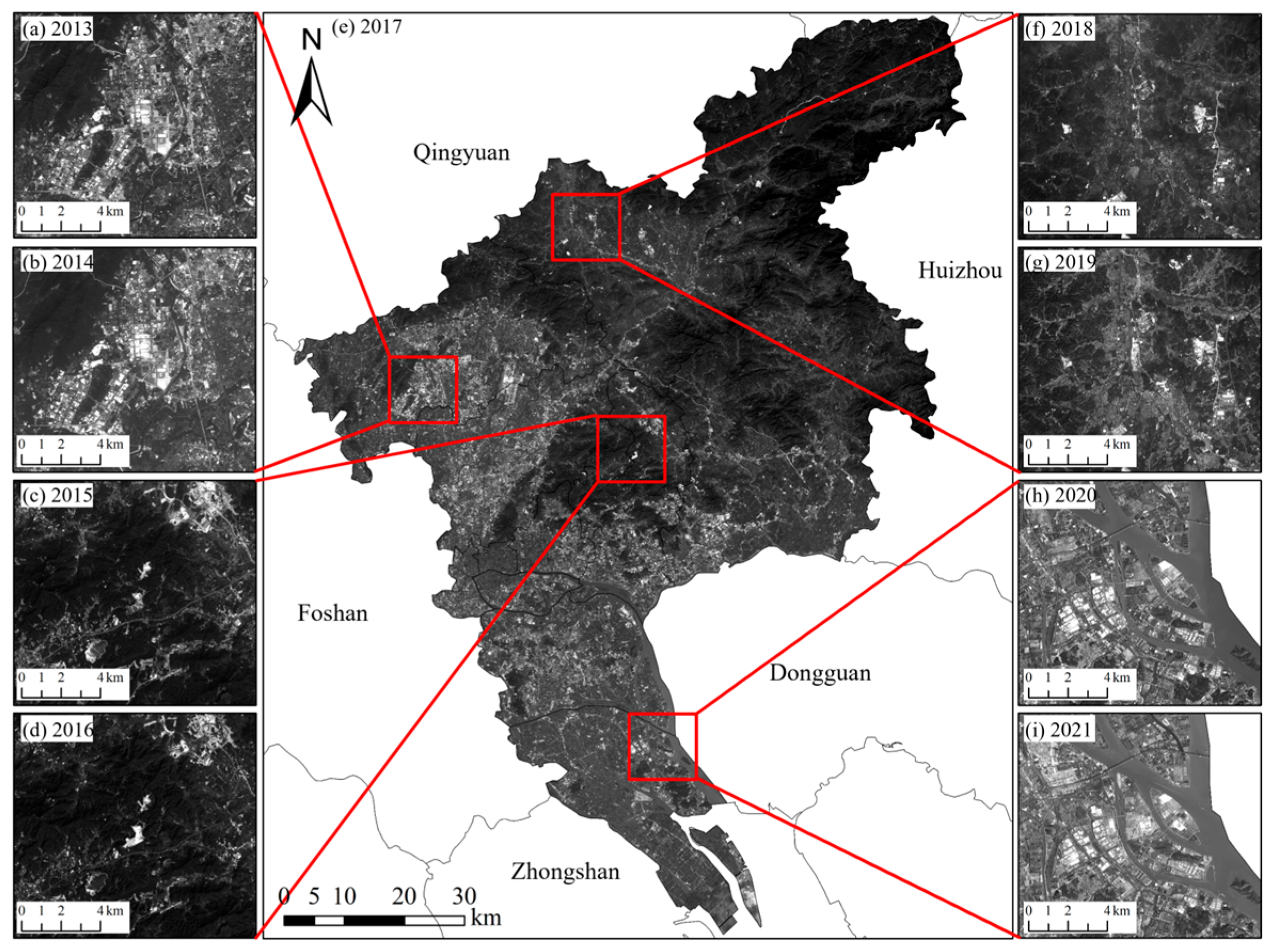
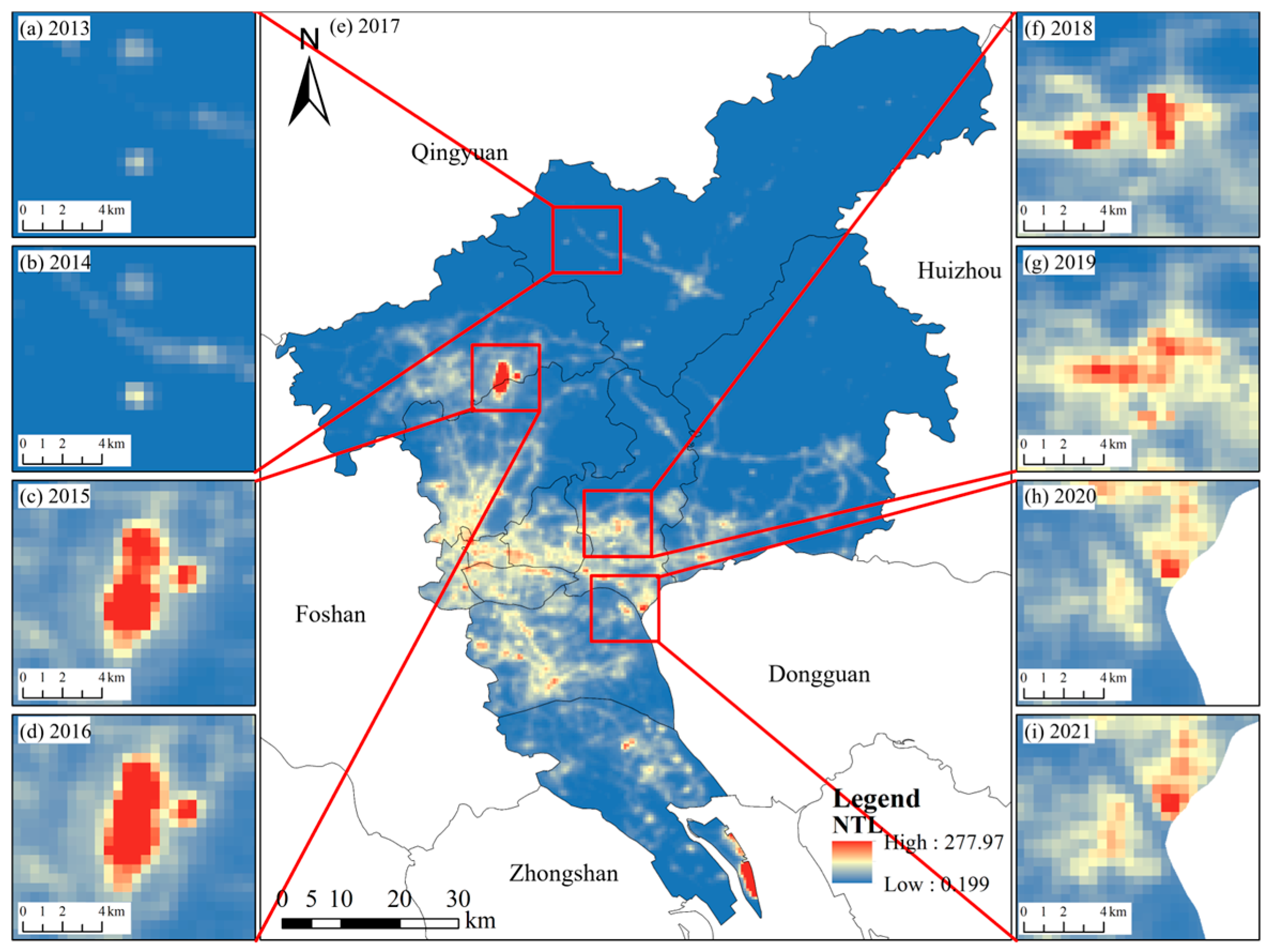
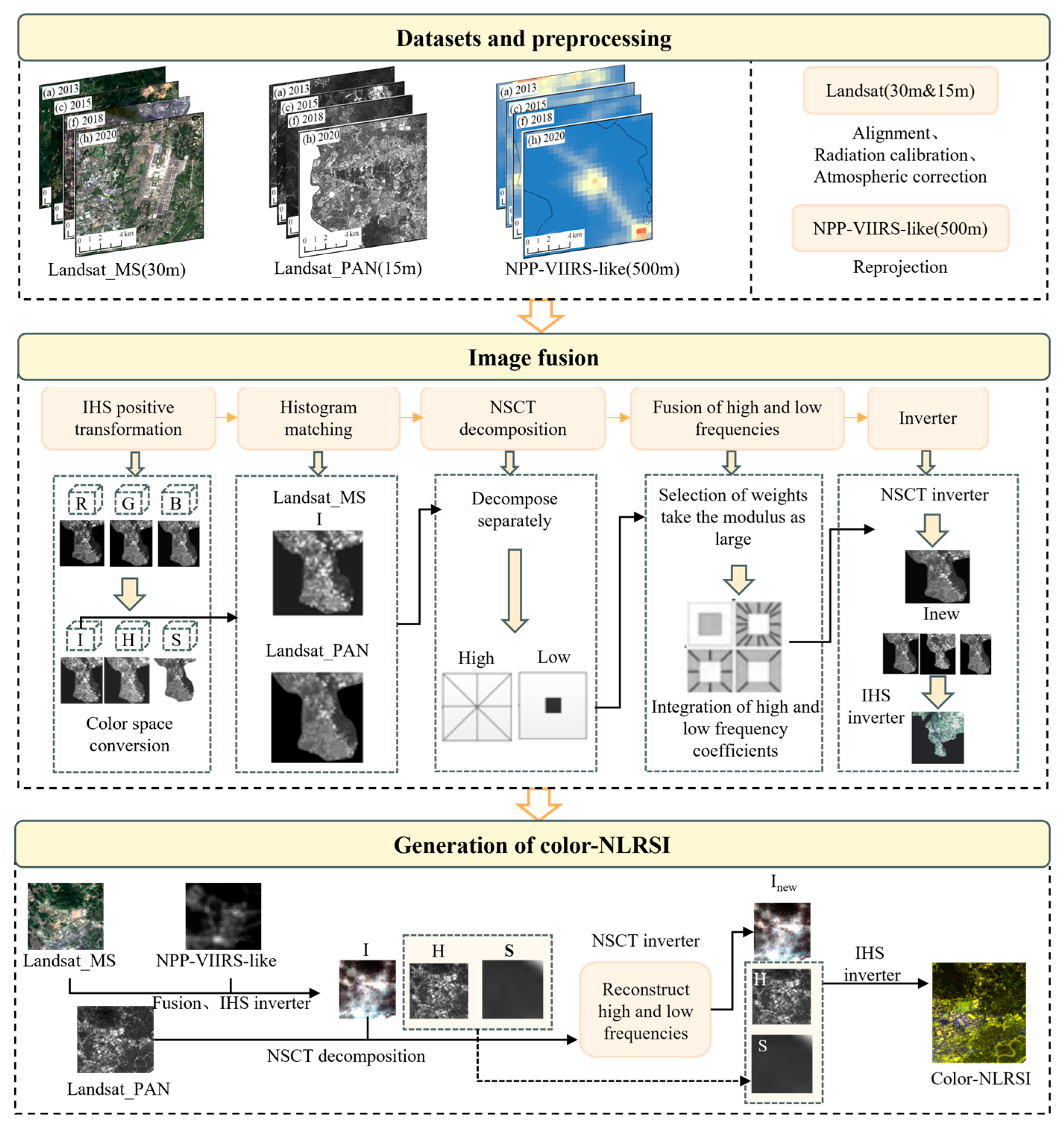
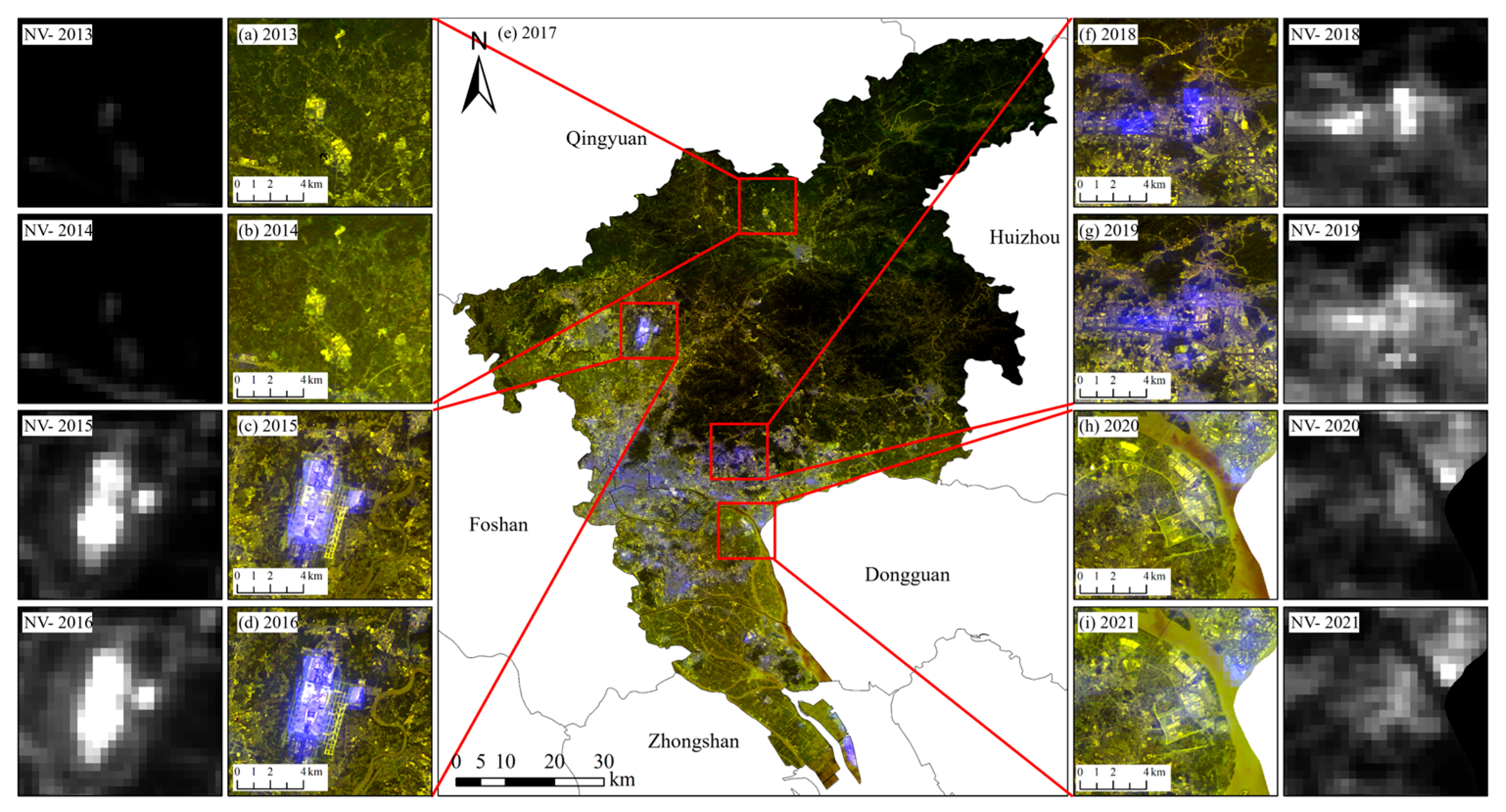
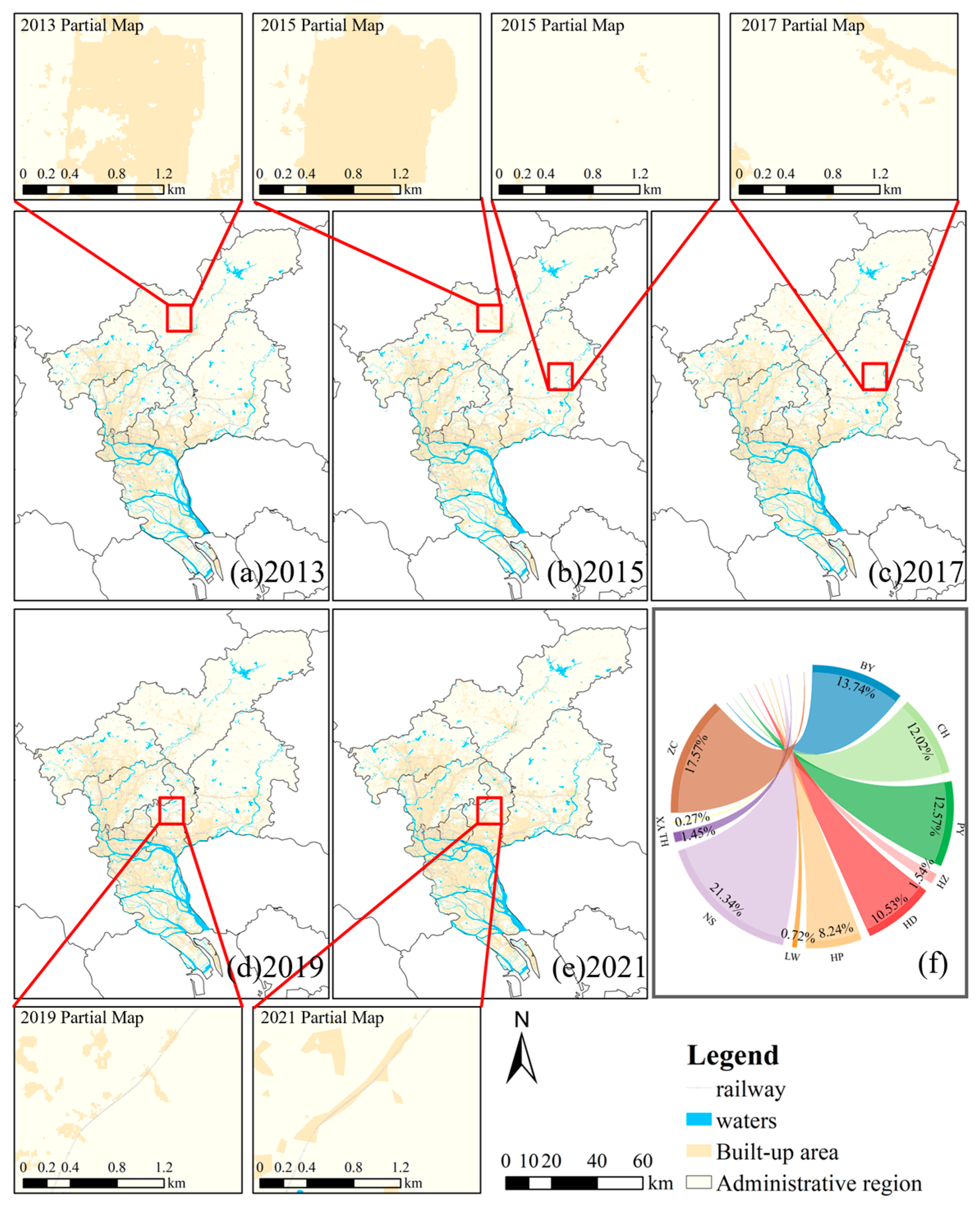
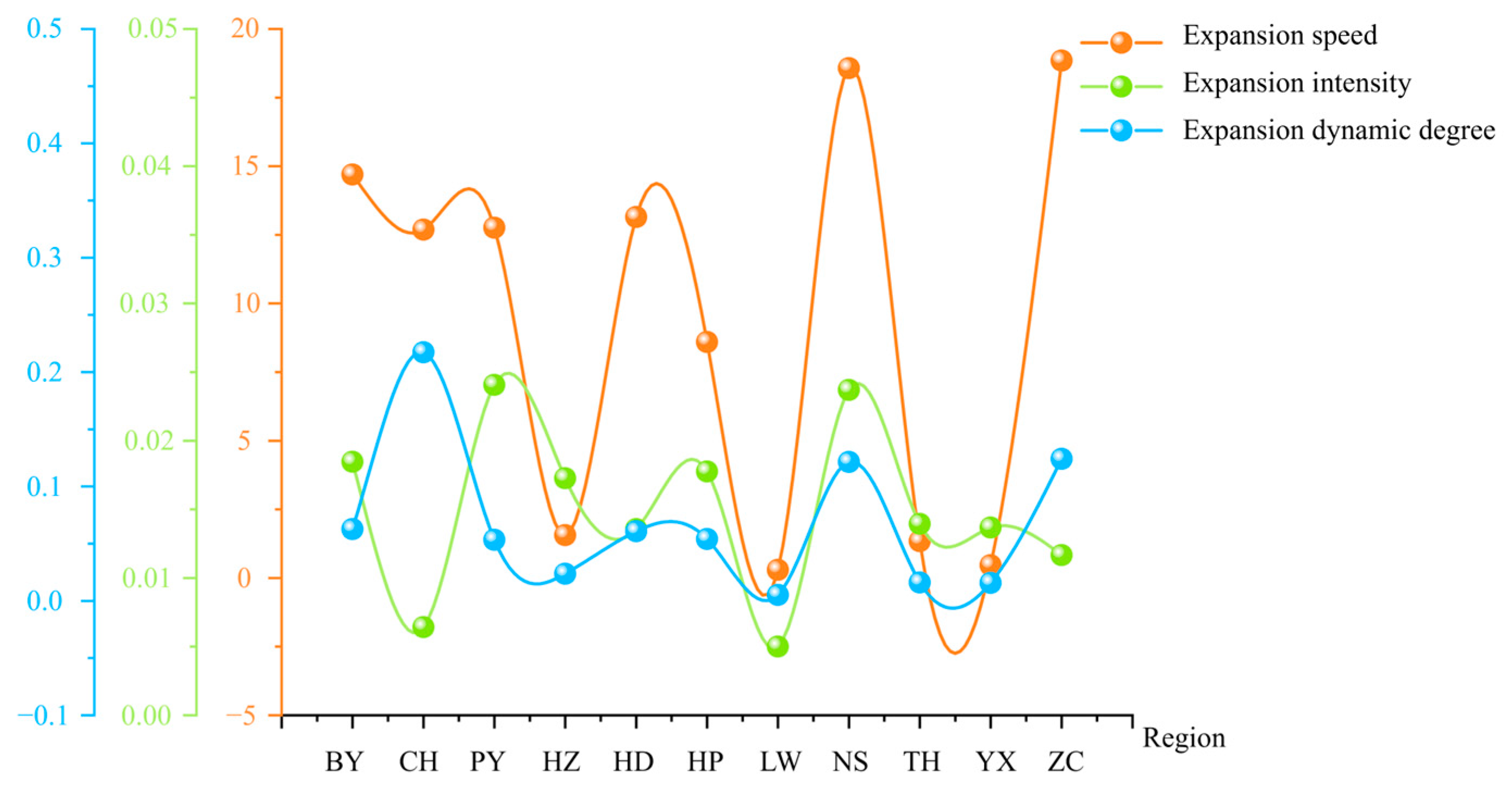
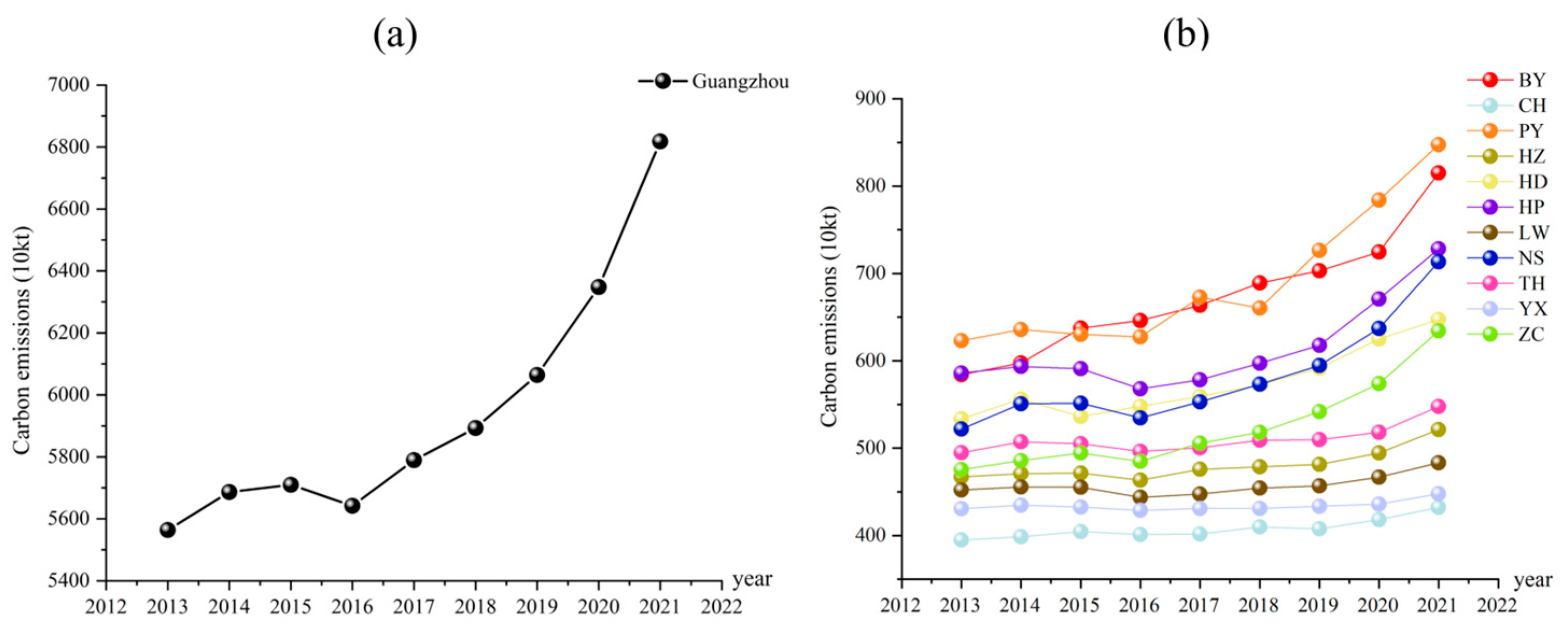

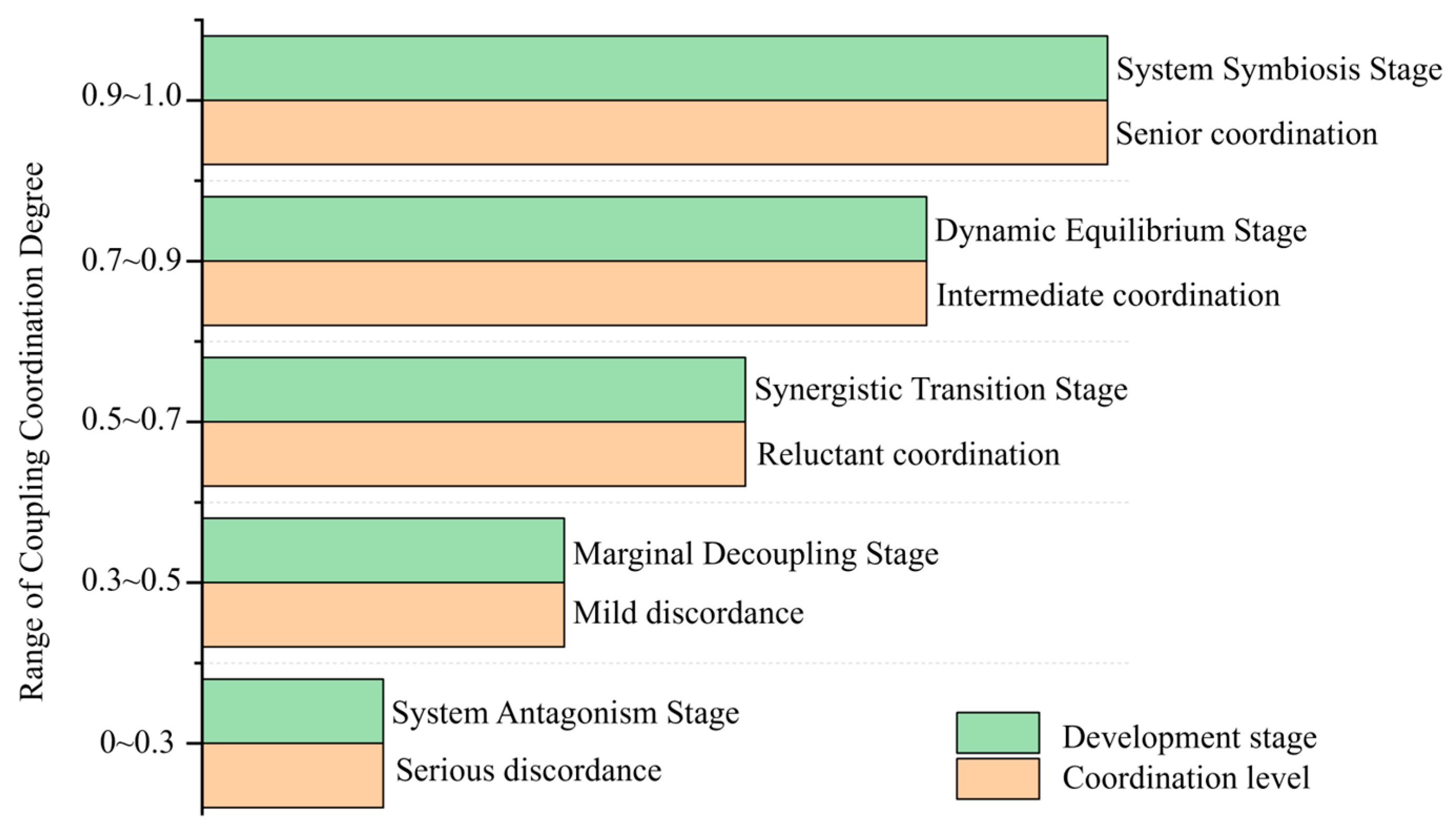

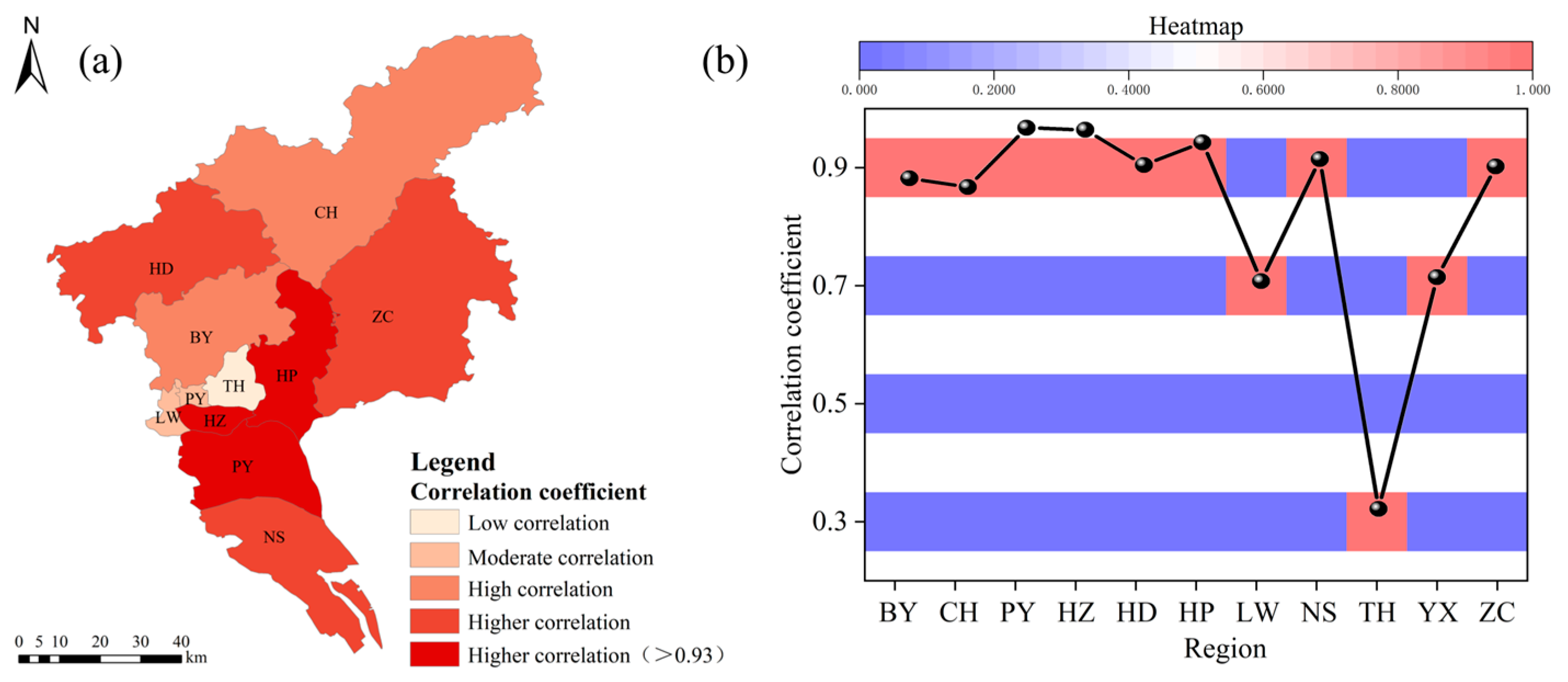

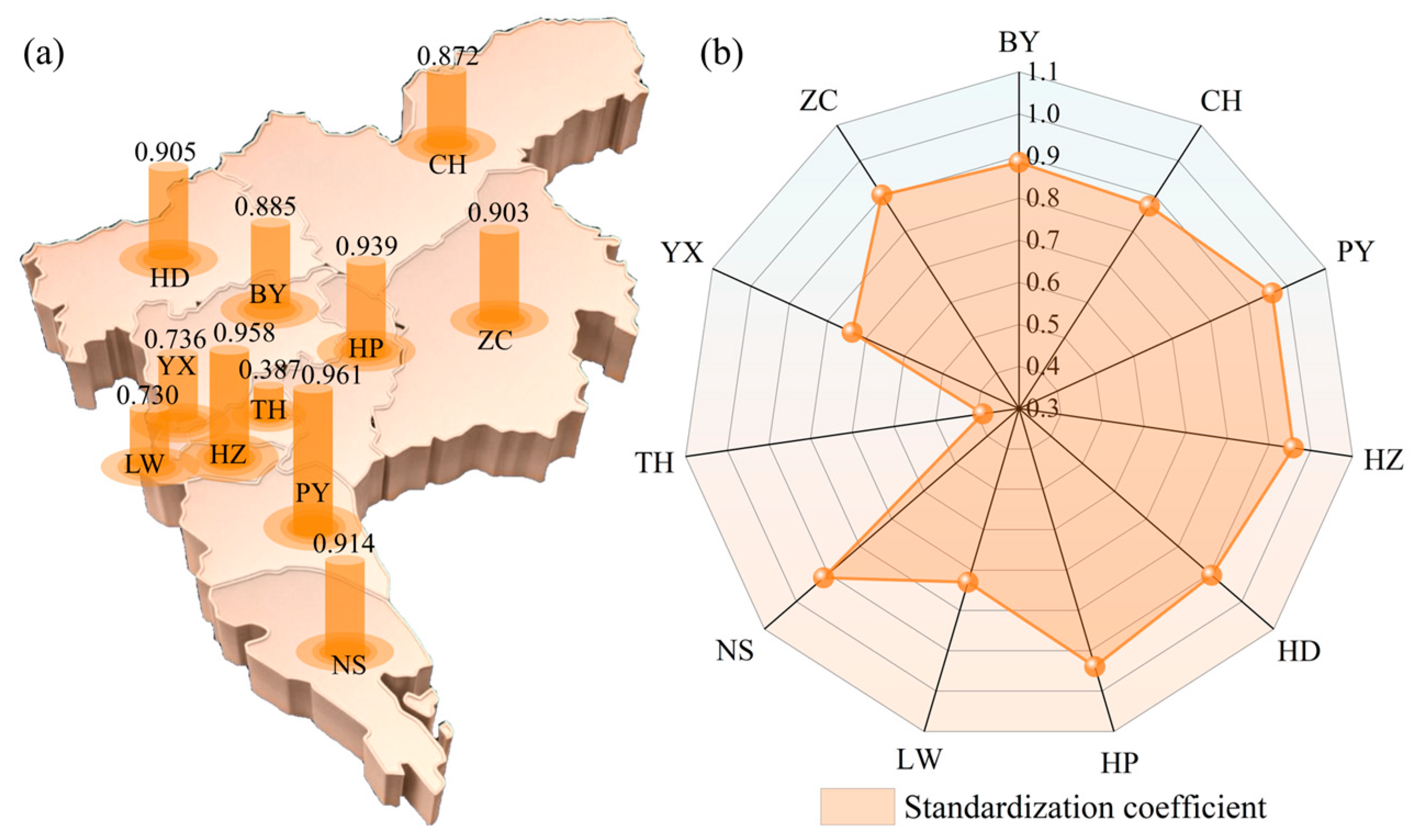
| Data Source | Overall Accuracy (OA) | Kappa Coefficient (KC) | Product Accuracy (PA) | User Accuracy (UA) |
|---|---|---|---|---|
| Color-NTL | 0.947 | 0.89 | 0.925 | 0.918 |
| NPP-VIIRS-like | 0.812 | 0.62 | 0.783 | 0.746 |
| Influencing Factors | Variance Inflation Factor | Standardized Coefficient |
|---|---|---|
| Urban Expansion | 2.590 | 0.358 |
| Economic Development Level | 2.406 | 0.165 |
| Rationalization of Industrial Structure | 1.190 | −0.835 |
| Urbanization Rate | 1.658 | 0.238 |
Disclaimer/Publisher’s Note: The statements, opinions and data contained in all publications are solely those of the individual author(s) and contributor(s) and not of MDPI and/or the editor(s). MDPI and/or the editor(s) disclaim responsibility for any injury to people or property resulting from any ideas, methods, instructions or products referred to in the content. |
© 2025 by the authors. Licensee MDPI, Basel, Switzerland. This article is an open access article distributed under the terms and conditions of the Creative Commons Attribution (CC BY) license (https://creativecommons.org/licenses/by/4.0/).
Share and Cite
Li, J.; Gong, X.; Lu, Y.; Jiang, J. Study on Spatiotemporal Coupling Between Urban Form and Carbon Footprint from the Perspective of Color Nighttime Light Remote Sensing. Remote Sens. 2025, 17, 3208. https://doi.org/10.3390/rs17183208
Li J, Gong X, Lu Y, Jiang J. Study on Spatiotemporal Coupling Between Urban Form and Carbon Footprint from the Perspective of Color Nighttime Light Remote Sensing. Remote Sensing. 2025; 17(18):3208. https://doi.org/10.3390/rs17183208
Chicago/Turabian StyleLi, Jingwen, Xinyi Gong, Yanling Lu, and Jianwu Jiang. 2025. "Study on Spatiotemporal Coupling Between Urban Form and Carbon Footprint from the Perspective of Color Nighttime Light Remote Sensing" Remote Sensing 17, no. 18: 3208. https://doi.org/10.3390/rs17183208
APA StyleLi, J., Gong, X., Lu, Y., & Jiang, J. (2025). Study on Spatiotemporal Coupling Between Urban Form and Carbon Footprint from the Perspective of Color Nighttime Light Remote Sensing. Remote Sensing, 17(18), 3208. https://doi.org/10.3390/rs17183208






